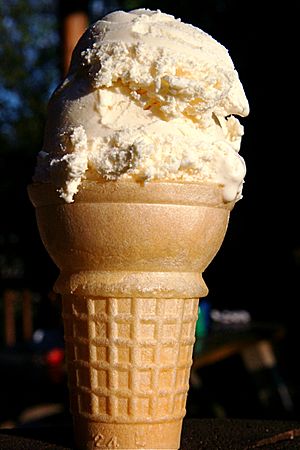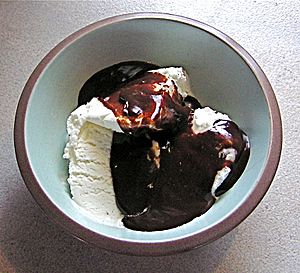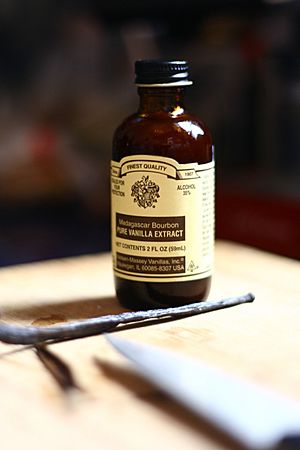Vanilla ice cream facts for kids

Vanilla ice cream is a very popular flavor of ice cream. It is enjoyed all over the world, especially in North America, Asia, and Europe. To make it, people mix cream, sugar, and vanilla. This mixture is then cooled down using ice and salt. This method helps the ice cream become smooth and creamy.
Different places like different kinds of vanilla flavor. In North America and Europe, people often like a strong, smoky vanilla taste. But in Ireland, they prefer a flavor that is more like anise, which is a spice. Many people think of vanilla as the "classic" or "plain" ice cream flavor.
Contents
How Vanilla Ice Cream Began
Vanilla was first used by the Mexica people in ancient Mexico. Around the 1510s, Spanish explorers came to Mexico. They saw local people using vanilla in their drinks and food. The vanilla bean was then taken back to Spain.
In Spain, vanilla was used to flavor a special strawberry drink. This drink had cacao beans, vanilla, corn, water, and ice. This popular drink soon spread to France, England, and other parts of Europe by the early 1600s. In 1602, a person named Hugh Morgan (apothecary), who worked for Queen Elizabeth I, suggested using vanilla on its own, not just with cocoa.
Ice cream itself has a long history, going back to the 1300s in China. There is also proof that ice cream was served in the Mogul Court in India. The idea of using ice and salt to keep things cold, which is key to making ice cream, came from Asia. This method traveled from the East to Europe when the Arabs and Moors went to Spain between 711 and 1492.
Once this cooling method reached Europe, the Italians started making ice cream. By the early 1700s, ice cream recipes appeared in France. The French made ice cream even smoother and richer by adding eggs or egg yolks. At first, French recipes did not include egg yolks, but they started to by the mid-1700s.
Vanilla became very popular in French recipes. The French used vanilla to flavor their "French vanilla" ice cream. Thomas Jefferson helped bring vanilla ice cream to the United States. He discovered the flavor in France and brought the recipe back home. In the 1780s, Thomas Jefferson even wrote his own recipe for vanilla ice cream. You can find this recipe at the Library of Congress.
In 2017, a false story spread online. It claimed that vanilla ice cream was originally black. It said the color was changed in 1912 because it "offended" white people. However, pictures from as early as 1876 show vanilla ice cream as a light, pale color.
How Vanilla Ice Cream is Made
In the 1700s in the United States, cooks needed a few things to make ice cream. They used a large wooden bucket, a metal freezing pot with a lid (called a sorbetiere), ice, salt, and the cream mixture.
First, they would find ice in small pieces. Then, they mixed the ice with salt and put it into the wooden bucket. The ice and salt together made a very cold environment. The cook would then pour their ice cream mixture into the freezing pot and put the lid on. This pot was placed inside the wooden bucket. The pot was stirred and shaken to make the ice cream creamy. From time to time, they had to open the pot to scrape the frozen ice cream off the sides. This work was often done by slaves and servants.
In 1843, Nancy M. Johnson invented the first ice cream maker with a crank on the outside. This crank helped mix the ice cream and scrape it off the sides of the pot at the same time. Before 1843, making ice cream took much longer. Nancy Johnson's invention made the process much easier.
After her invention, companies started using ice cream makers powered by horses, steam engines, and later, electric motors. People at home also began using electric ice cream makers. Making ice cream became more common when sugar became cheaper and ice was easier to get. After the American Civil War, ice cream prices dropped, and more companies started making and selling it.
Different Vanilla Flavorings
Ice cream can be flavored with either natural or artificial vanilla. Artificial flavorings mostly contain a chemical called vanillin. This is the main thing that gives natural vanilla its flavor. However, natural vanilla extract has almost 200 other compounds besides vanillin. These extra compounds give natural vanilla a richer, more complex taste.
Vanilla ice cream can be named differently based on how it's flavored:
- If it uses natural vanilla extract, it's called "vanilla ice-cream."
- If it uses vanillin that comes from natural vanilla, it's called "vanilla flavored ice cream."
- If it uses artificial vanillin, it's called "artificially flavored vanilla ice-cream."
The Food and Drug Administration (FDA) in the United States has rules for how vanilla ice cream is labeled. They divide it into three groups based on its ingredients.
See also
 In Spanish: Helado de vainilla para niños
In Spanish: Helado de vainilla para niños




